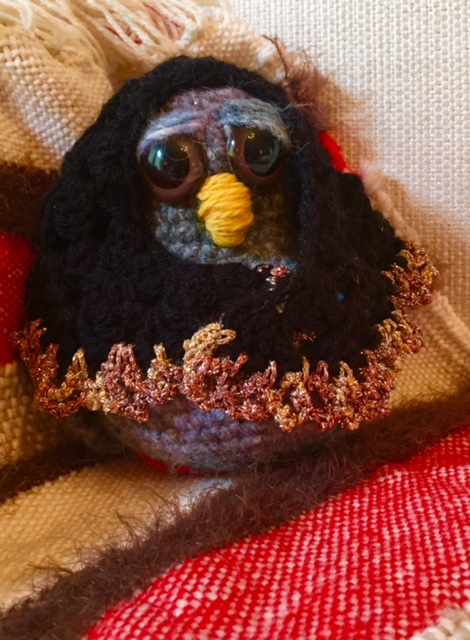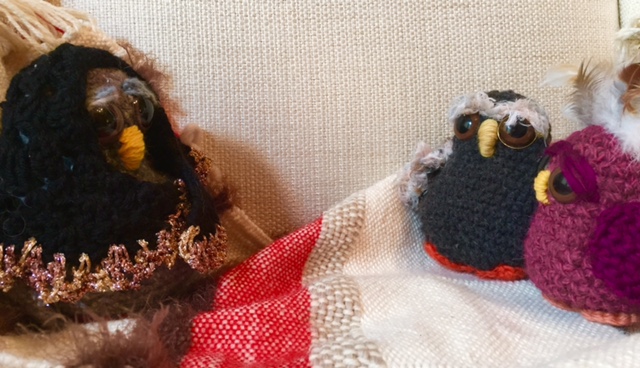Hello, Dear Readers.
We have a new guest speaker to introduce. Please meet Nanna. She has come to us after many of life’s trials and tribulations. These include heartbreak, loss, grief and change of plans. But, Nanna is more than her pain and her burdens. She is wisdom and she has carried on through prayer, practice, ritual and faith. Nanna has also enjoyed the throes of romantic love, the blessings of motherhood and the anchor of deep friendship. She is a rare bird in these parts, these days, and she wanted to be able to share what she has learned during her long time on Earth. Realta and Sherman are overjoyed to be with her.

HH: Nanna, it’s so nice to have you join us. What is on your mind today?
Nanna: It is wonderful to be here and to have someone want to hear what I think about. It’s been a while since anyone has asked. Today, I am thinking about ritual, and work. After meeting many folks, feathered and otherwise, I am sensing great longing and hearing some confusion about what it is to have faith and practice. Not all beings need to embrace religion, of course. I am of the old world. Church does not offend me or scare me. I see it as a place to commune with God, the Great Spirit, the Holy Mother and Holy Father. I see it as a place to meditate, to pray, to find peace. But that is not what I mean by faith. Using that word is a choice and is meant to reflect rather a sense of connection with everything. To believe that there is a connection to Every Thing. I have also been thinking about ritual. Quiet prayers. Kneeling, standing. Chanting. Ritual has been a part of lived experience for millennia, and to some extent, I see it’s absence in modern culture creating vacuums where anxiety and distraction lie.
HH: What do you mean by ritual? To many, that word conjures images of formality and discipline within a dogmatic religious sphere.
Nanna: Well, I’ve learned over time that cultures and religions all have their own rituals. They are merely repeated acts, usually done in a certain order to support some kind of ceremony. Of course it is true that ritual plays an enormous part in what we do in the religious context. But that is not the only place where ritual lives.
What I think about is, why ritual? Why have we been doing ritualized things for so long? There is some kind of ordering principal to ritual, perhaps that establishes a mood, prepares the psyche for a set of experiences, etc. It seems important when considering how we have evolved over time.
HH: As someone who does not attend church but has enjoyed the rites and rituals of several different faiths I’ve been exposed to, I understand what you mean. What would you say to someone who does not identify with a specific religion?
Nanna: I’d say that ritual is all around us and that likely if we tune in to what we are doing, we’d see the pull towards ritualized archetypal practice. Look at the weaving you just completed. My guess is that before you began your piece, you had an image in mind, an intention, a hope. Maybe you thought of a person, or a place when you sat down to begin your work. You went through the process of warping your loom, walking back and forth, wrapping yarn around the peg. Did you do that rhythmically? Was there a beat? A resonance? Likely there was, even if you weren’t conscious of it. It’s hard to do that kind of work without it.
Once warped, you set to the process of weaving, back and forth with the shuttle, up and down with the heddle. You may have been praying, thinking, spacing out or tuning in , but you were making. Here and there on your piece, you can see areas where you got stuck or maybe had too tight or too lose of a warp thread. Learning and life captured in fabric. The work of the hands with materials, in my mind, is a form of ritual.

HH: I never thought of it like that. It’s funny that you can see my warp errors. Definitely still learning. But even though this is new for me, to weave on a rigid heddle loom, I still found the rhythm and the flow eventually. It’s the thing I love about weaving. Once you hit that flow you can let go and create at the same time, and make something tangible and useful. Spinning, too.
Nanna: Yes. That is what I like about it, too. And you know, there are cultures around the world for whom weaving and the dyeing of wool was a very spiritual and symbolic process. Patterns, shapes, the weavers themselves were and still are all part of the act of creation. Look at the goddesses all over the world who are associated with weaving and spinning: Frigg, Arachne, Maya to name a few. These goddesses’ stories tell tales of life, death, the merging of spirit and the corporeal.
I like this quote from John O’Donohue’s Eternal Echoes. I think it captures the aspect of weaving and other crafts that is of the hands. I am making an arch between the essence of using one’s hands to create and ritual, which creates a deeply personal relationship with our world and nature, our functionality and our usefulness.
“The whole structure of the human body anticipates and expects the presence of others. Hands reach out to embrace the world. Human hands are powerful images. Hands painted the roof of the Sistine Chapel and the heavenly women on the wall of Sigeria, wrote the Paradiso, sculpted the David; in Auschwitz, hands rose to bless the tormentors. Hands reach out to touch and caress the lover. Hands build walls, sow gardens, and direct symphonies… The whole history of our presence on earth could be gleaned from the witness and actions of hands. One of the great thresholds in human civilization was the development of tools with which we changed and civilized the landscape. The use of simple tools still meant personal contact with Nature. In these times, we have crossed another threshold where the tool is replaced by the mechanical instrument. The instrument is a means of exercising a function. With the development of instrumentalization, so much of our work and engagement with the world is no longer hands-on. Rather, our hands press the key and the instrument expedites the action. Instrumentalization saves labour but at the cost of direct contact with the world.” (pgs. 60-61).
I chose that piece to share because it is relevant to what I see happening today, a call back to the traditional skills that requires that individuals touch tools, land and nature. There is a reason handcrafting is such a powerfully moving medium these days. I do not believe it is a fad. I believe it is a call to re-engage with our hands, with our connection to Earth, to Nature, to our own resourcefulness and perhaps to having a good appreciation for what something is worth. Weaving, in many ways, can be seen as ritual made physical; ritual made practical. If one allows for it, weaving, knitting, crochet, spinning fibers… they all can serve as grounding and meditative experiences. That is beautiful because that is day-to-day life. Religion or no religion, engagement with materials can be meditative, instructive of our own nature and can bring us into alignment with our surroundings.

HH: So, you don’t think attending a specific church is necessary to gain this wisdom?
Nanna: Of course not! People all over the world have their own ways of attending to their relationship with their own spirituality, if they so wish. Organized, not organized… this is an entirely personal choice. What I am saying is that the call to ritual is apparently very important to the core of being, as it has been with us since documentation of any kind began. And, we can access that call through handwork, through handy-work, through engagement with our land and through an abiding respect for nature. Isn’t that wonderful?
HH: You are making me want to warp my loom again!
Nanna: Good.
You can expect more from Nanna here on Healing Handcrafting in the future.

May 31, 2017 at 9:24 pm
Well I just fell in love with Nanna. I’m excited to hear more from her ❤
LikeLiked by 1 person
May 31, 2017 at 9:32 pm
Oh, you will! Tip of the iceberg ❤️
LikeLike
June 1, 2017 at 11:28 am
This is a neat approach to discussing ideas that are heavy and could be off-putting to a casual reader. Nanna has her own voice!
LikeLiked by 1 person
June 1, 2017 at 1:37 pm
Thank you! It was fun to write.
LikeLike